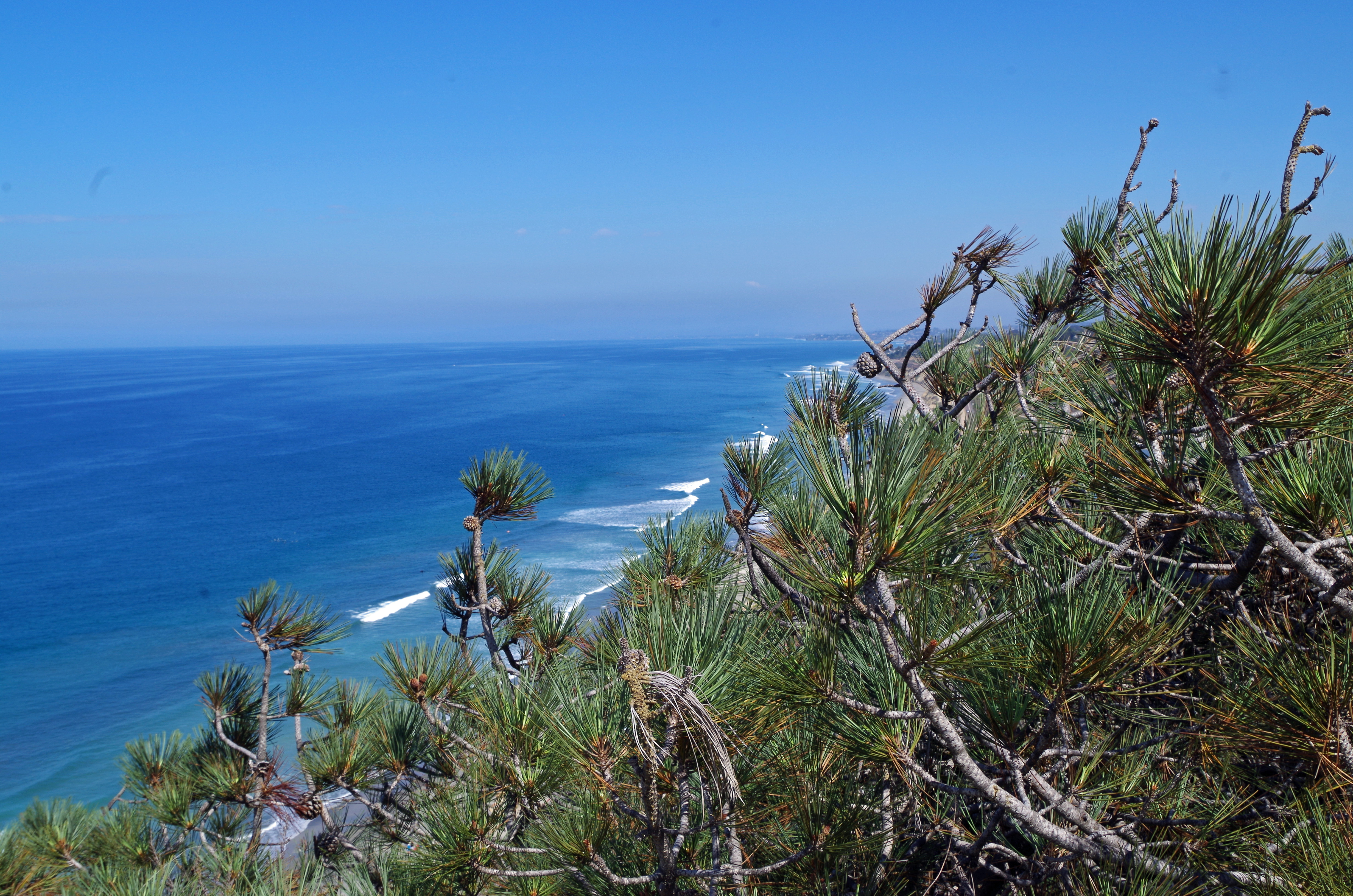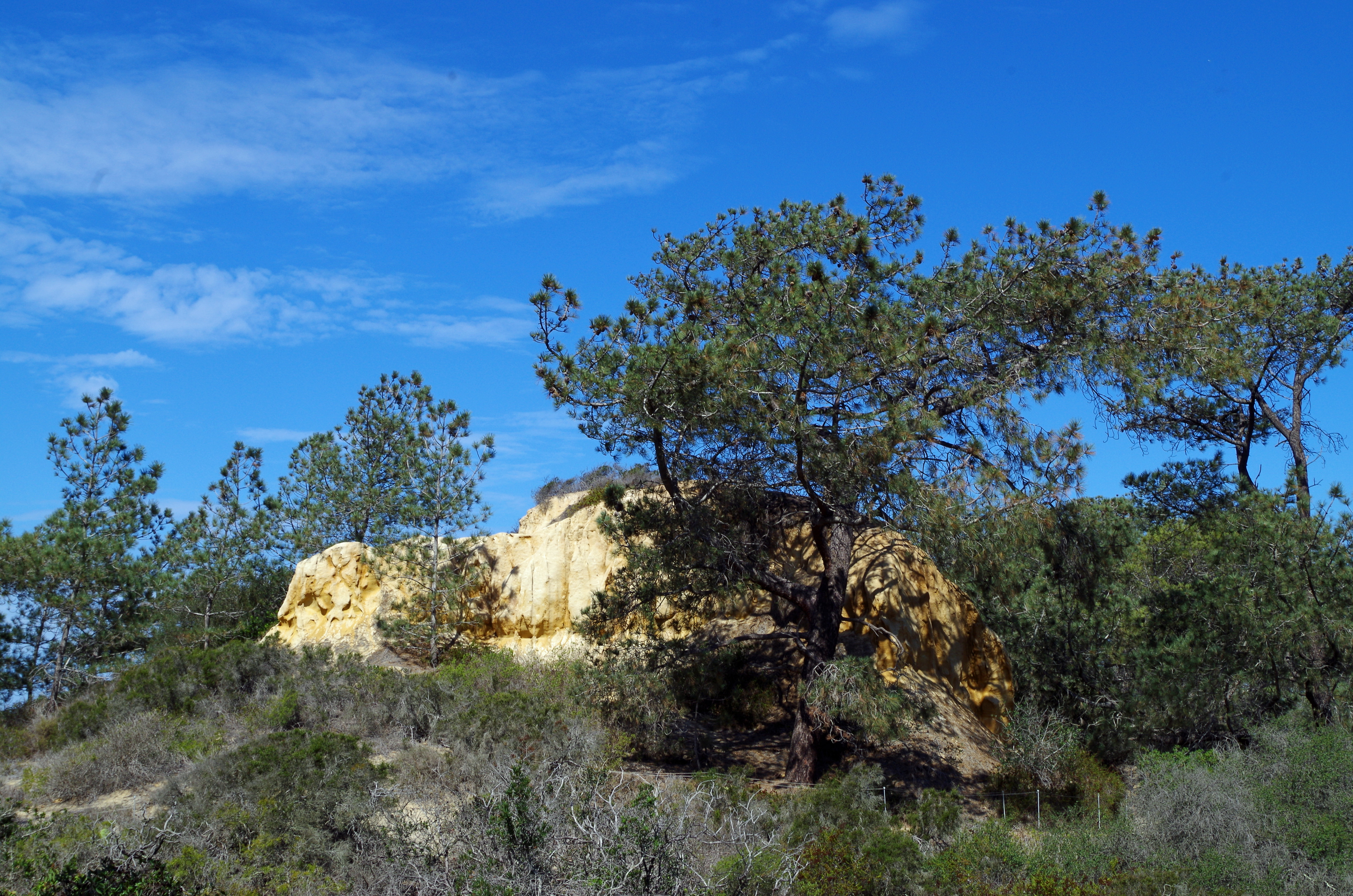Brief Community Description
Torrey pine forest is an open to moderately dense forest dominated by the Torrey pine, Pinus torreyana, and by Quercus dumosa, Cneoidium dumosum, and Eriogonum fasciculatum [1, 2]. Fog may provide moisture to the forest throughout the year, but is less common in winter and late spring. Most growth and flowering occurs during the rainy season in late winter and spring, but growth may occur outside of those seasons at more mesic sites. The canopy is open with trees less than 15 meters tall. There are 3 MSP species associated with Torrey pine forest vegetation.
Alliances
Torrey pine forest is the only pine forest in coastal southern California [3, 4; cited in 5] and is classified in the Vegetation Classification Manual for Western San Diego County as Pinus torreyana Special Stands [2], a classification similar to an alliance but dominated by a rare, special status species. The dominant tree species are Torrey pines and Quercus dumosa, with Cneoidium dumosum, and Eriogonum fasciculatum as dominant shrubs [2]. Other characteristic coastal sage scrub and chaparral shrubs, include Adenostoma fasciculatum, Xylococcus bicolor, Ceanothus verrucosus, Cerocarpus minutiflorus, Rhus integrifolia, Artemisia californica, Salvia mellifera, and Malosma laurina. The shrub and herb layer are subdominant with low cover and diversity. Torrey pine forest intergrades with southern California bluff scrub and southern mixed chaparral [1]. Pine crowns may be equally dispersed across the landscape regardless of understory shrubs. This lack of pattern with the associated understory shrubs adds confusion to stand identification [2].
Range wide dist. status
The slow-growing Torrey pine is the rarest pine in North America [7; cited in 5], with only two natural populations. The mainland population occurs in and around Torrey Pines State Reserve (TPSR) and the other population occurs on Santa Rosa Island off the coast of southern California [5]. In 2006, the Torrey pine population in TPSR consisted of 5,394 individuals and age structure was comprised of 71% adults, 16% sub-adults, 8% saplings, and 5% seedlings [11], which is consistent with earlier observations of large, mature trees, with infrequent seedlings and saplings [10; cited in 5]. Stand population structure appears to persist over time [13; cited in 5; 11] and varies between stands due to patchy juvenile recruitment [11]. It is likely that stand age will continue to increase in some stands, given the rate of seedling establishment and survival in the past [13; cited in 5].
MSPA distribution
There are 176 acres of Torrey pine forest in the MSPA in MUs 6 and 7, of which 171 acres are conserved. There is 1 acre in MU6 that is not conserved and there are 175 acres in MU7 (171 acres conserved).
Habitat affinities
The TPSR population is restricted to the low coastal bluffs bordering the Soledad Valley, and consists of approximately 7,000 trees [8, 9]. Torrey pine forests occur on rocky sandstone soils in areas of mild climate with low precipitation [1]. Understory varies from nearly nothing on the driest and rockiest sites to fairly dense chaparral on generally rocky soils. Understory may be dominated by mesic or xeric chaparral species and/or coastal scrub species [2].
Ecosystem processes
Infrequent fire may enhance regeneration given that seed drop is substantial following a crown fire [3, 10; both cited in 5]. Seedling establishment also increases with fire [5], likely due in part to the Torrey pine’s serotinous cones and delayed seed dispersal [11, 3; both cited in 5]. This allows the trees to release a substantial amount of seeds immediately following a fire to take advantage of the disturbance conditions, and it also allows the tree to release the remaining seeds gradually for the next 13 years [12]. The wings on Torrey pine seeds are vestigial, making the seeds unlikely to disperse far from the parent tree (less than 4 meters) [14]. Fire would likely increase the cover and diversity of the shrub and herb layer [2].
Threats
Very few seedlings survive to reproductive age, with water stress in July and August the leading cause of mortality [5, 3; cited in 5], highlighting the sensitivity of seedlings to drought and drier conditions [5, 3; cited in 5]. Additionally, due to low genetic variability, Torrey pines have little ability to respond to change through natural selection [5]. Another threat to the Torrey pines is air pollution due to the proximity to densely populated San Diego [3]. A bark beetle infestation in the late 1980s-early 1990s killed 12% of adult Torrey pines. This infestation was controlled with the placement of synthetic pheromones in traps to attract and capture the beetles. The recent prolonged drought has led to a resurgence in 2014-2016 of bark-beetle caused mortality and current management includes cutting down and removing infested trees, watering trees, and trapping to remove beetles [16, 17, 18].
Special considerations
Managers at TPSR may want to consider control burns to promote a more natural setting that fire-exclusion has prevented. These control burns would have to mimic the infrequent, severe fires that promote Torrey pine seedling establishment. Fires should not occur in intervals shorter than 12-18 years, as they could kill the saplings when they reach reproductive age [3; cited in 5]. A 2011 study by Janet Franklin and Elizabeth Santos examined all of the Torrey pines in TPSR and the extension [15]. Their report provides a baseline dataset for continued monitoring. The population map can be used to monitor seedling recruitment and adult survival.
Sources
[1] Oberbauer, T. A., M. Kelly, and J. Buegge. 2008. Draft Vegetation Communities of San Diego County. Based on “Preliminary Descriptions of the Terrestrial Natural Communities of Californiaâ€, Robert F. Holland, Ph.D., October 1986. San Diego, CA.
[2] Sproul, F., T. Keeler-Wolf, P. Gordon-Reedy, J. Dunn, A. Klein, and K. Harper. 2011. Vegetation Classification Manual for Western San Diego County. First Edit. San Diego, CA.
[3] McMaster, G. S. 1980. Patterns of Reproduction in Torrey Pine (Pinus Torreyana). San Diego State University.
[4] Remeika, P. 1976. Torrey Pines. Environment Southwest 475: 10–12.
[5] Esser, L. L. 1993. Index of Species Information: Pinus Torreyana. Fire Effects Information System. http://www.fs.fed.us/database/feis/plants/tree/pintor/all.html.
[6] CNPS. 2016. Pinus Torreyana Woodland Special Stands. Accessed October 27. http://vegetation.cnps.org/alliance/65.
[7] Dusek, K. H. 1985. Update on Our Rarest Pine. American Forests 91: 21–69, 61, 63.
[8] Critchfield, W. B., and E. L. Jr. Little. 1966. Geographic Distribution of Pines of the World. USDA Forest Service Miscellaneous Publication 991: 1–97. doi:10.5962/bhl.title.66393.
[9] Little, E.L Jr. 1975. Rare and Local Conifers in the United States. Conservation Research Report. Vol. 19. Washington D.C.
[10] Zedler, P. H., Gerald Schneid, and Carla Scheidlinger. 1987. Fire in the Ecology and Management of Torrey Pine (California). Restoration & Management Notes 5: 88–89.
[11] Evarts, B. 1986. Torrey Pines: Resurrection or Remission. Environment Southwest 514: 3–8.
[12] McMaster, G. S., and P. H. Zedler. 1981. Delayed Seed Dispersal in Pinus Torreyana (Torrey Pine). Oecologia 51: 62–66.
[13] McMaster, G. 1982. Fire in the Ecology and Management of Torrey Pine (Pinus Torreyana) Populations. In Proceedings of the Symposium on Dynamics and Management of Mediterranean-Type Ecosystems, edited by Conrad Eugene and Walter C. Oechel. San Diego, CA: USDA Forest Service, Pacific Southwest Forest and Range Experiment Station.
[14] Franklin, J., and E. V. Santos. 2011. A Spatially Explicit Census Reveals Population Structure and Recruitment Patterns for a Narrowly Endemic Pine, Pinus Torreyana. Plant Ecology 212: 293–306. doi:10.1007/s11258-010-9822-x.
[15] California Department of Parks and Recreation News Release. 2014. Infested Trees to be Cut Down at Torrey Pines State Natural Reserve. Accessed November 23, 2016. https://www.parks.ca.gov/NewsRelease/469
[16] The Sacramento Bee. 2015. Bark Beetles Empowered by Drought Threaten Rare Torrey Pines. October 17, 2015. Accessed November 23, 2016. http://www.sacbee.com/news/politics-government/capitol-alert/article39618351.html
[17] The San Diego Union Tribune. 2016. City looks for new ways to battle bark beetles. March 8, 2016. Accessed November 23, 2016. http://www.sandiegouniontribune.com/news/environment/sdut-del-mar-bark-beetle-2016mar08-story.html

